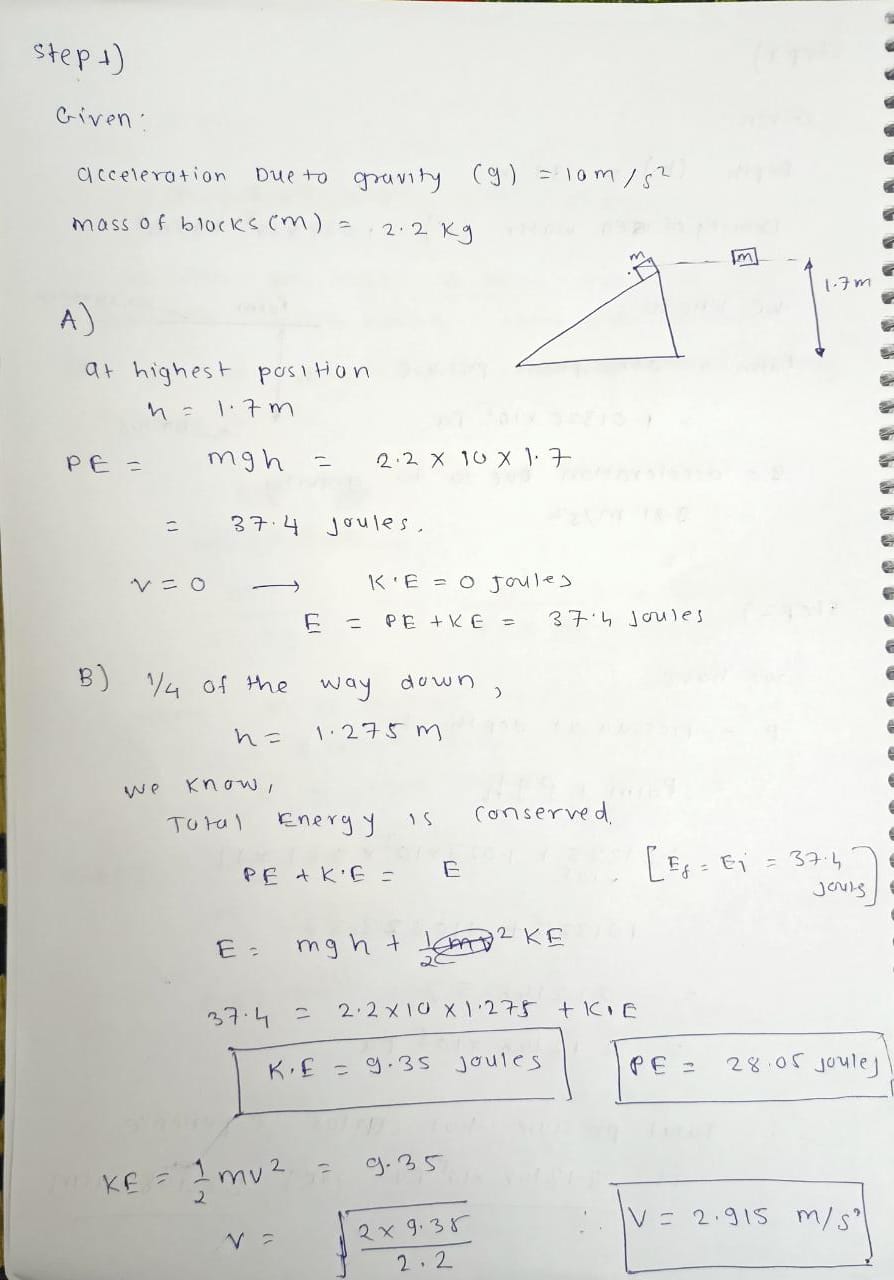Let's see if you can apply what you learned about conservation of energy to predict information about potential energy, kinetic energy, and total energy of the system. This question is very similar to the question with the pendulum. In the figure below, two blocks of equal mass 2.2 kg are located a vertical distance of 1.7 m above the ground. One block will be released and allowed to fall vertically while the other will be released at the top of the incline and will be allowed to slide down the frictionless incline. As we discussed motion, we learned how to find the speed of an object as if falls through a certain vertical height under the influence of gravity. In this exercise, we will consider the motion from the perspective of energy conservation. It turns out that any given position the speed of both blocks will be identical. This doesn't mean that once released they will be at the same vertical position at the same time, but they will have the same speed. Using the fact that the blocks are released from rest at the maximum vertical position and energy is conserved. Fill in the table below for PE, KE, E = KE + PE, and speed of the block. We assume that the acceleration due to gravity is 10 m/s2. Remember that due to conservation of energy, the total combined energy of potential + kinetic at any location must be the same. Start by determining the potential energy, PE = m g h, at the highest position. At this position, the block is releases from rest and thus has zero KE and velocity. Use the highest position to determine the total energy of the system, E = KE + PE. Once you know the energy, E, at the highest point, you also know the energy at all other locations since energy is conserved. Next, calculate the PE at the position 1/4 of the way down the incline. Once you know PE, solve for the KE using the fact that PE + KE = E. Once you know the kinetic energy for, use the fact that KE = 1/2 m v2 to calculate the speed of the block at this position. Repeat this for the other positions. Figure PE (J) KE (J) E = PE + KE speed (m/s) (A) highest position h = 1.7 m 0 0 (B) 1/4 of the way down, h = 1.275 m (C) midway to lowest position, h = 0.85 m (D) 3/4 of the way down, h = 0.425 m (E) lowest position h = 0 m
Let's see if you can apply what you learned about conservation of energy to predict information about potential energy, kinetic energy, and total energy of the system. This question is very similar to the question with the pendulum. In the figure below, two blocks of equal mass 2.2 kg are located a vertical distance of 1.7 m above the ground. One block will be released and allowed to fall vertically while the other will be released at the top of the incline and will be allowed to slide down the frictionless incline. As we discussed motion, we learned how to find the speed of an object as if falls through a certain vertical height under the influence of gravity. In this exercise, we will consider the motion from the perspective of energy conservation. It turns out that any given position the speed of both blocks will be identical. This doesn't mean that once released they will be at the same vertical position at the same time, but they will have the same speed. Using the fact that the blocks are released from rest at the maximum vertical position and energy is conserved. Fill in the table below for PE, KE, E = KE + PE, and speed of the block. We assume that the acceleration due to gravity is 10 m/s2. Remember that due to conservation of energy, the total combined energy of potential + kinetic at any location must be the same.
Start by determining the potential energy, PE = m g h, at the highest position. At this position, the block is releases from rest and thus has zero KE and velocity. Use the highest position to determine the total energy of the system, E = KE + PE. Once you know the energy, E, at the highest point, you also know the energy at all other locations since energy is conserved. Next, calculate the PE at the position 1/4 of the way down the incline. Once you know PE, solve for the KE using the fact that PE + KE = E. Once you know the kinetic energy for, use the fact that KE = 1/2 m v2 to calculate the speed of the block at this position. Repeat this for the other positions.
| Figure | PE (J) | KE (J) | E = PE + KE | speed (m/s) |
| (A) highest position h = 1.7 m | 0 | 0 | ||
| (B) 1/4 of the way down, h = 1.275 m | ||||
| (C) midway to lowest position, h = 0.85 m | ||||
| (D) 3/4 of the way down, h = 0.425 m | ||||
| (E) lowest position h = 0 m |
Only three subparts per question. please post remaining questions

Trending now
This is a popular solution!
Step by step
Solved in 2 steps with 2 images









